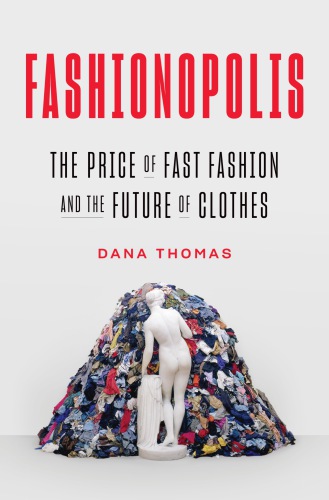
Fashionopolis
The Price of Fast Fashion - and the Future of Clothes
کتاب های مرتبط
- اطلاعات
- نقد و بررسی
- دیدگاه کاربران
نقد و بررسی

May 27, 2019
In this informative volume, fashion journalist Thomas convincingly lays out multiple arguments against fast fashion (low-cost, mass-produced clothing) and the cycle of rapidly manufacturing, purchasing, and discarding clothes that is sweeping the globe. Thomas points out that American “shoppers snap up five times more clothing now than they did in 1980,” that fast fashion also preys on consumers’ insecurities, that synthetic dyes and fertilizers have harmful effects on the environment, that southern mill towns emptied when clothing manufacturers sent those jobs overseas, and that outsourcing grievously exploits laborers (as evinced by the devastating collapse of Rana Plaza in Bangladesh, where many U.S. companies subcontracted work, which killed more than 1,000 garment workers). In the latter part of the book, Thomas delves into efforts to mitigate these effects through “slow fashion,” such as Levi’s using domestically produced organic indigo for some of its denim, and small, socially conscious companies bringing their manufacturing operations back to the U.S. Thomas interviews individuals such as Alabama Chanin, who grew up in Florence, Ala., “the Cotton T-shirt Capital of the World,” and, upon returning home, has reimagined how clothing can be produced locally in a manner that exploits neither its employees nor the environment. Thoroughly reported and persuasively written, Sexton’s clarion call for more responsible practices in fashion will speak to both industry professionals and socially conscious consumers.

July 15, 2019
An educated update on the current state of fashion, how it got there, and a prognostication on its precarious future. Paris-based fashion journalist Thomas (Gods and Kings: The Rise and Fall of Alexander McQueen and John Galliano, 2014, etc.) offers informed, fair-minded, passionate, and cautiously optimistic scrutiny of "fast fashion," which entails "the production of trendy, inexpensive garments in vast amounts at lightning speed in subcontracted factories, to be touted in thousands of chain stores." The author focuses on the negative ramifications of this rampant consumerism, which gives little regard to garment quality or manufacturing origins. Among the "casualties" of this trend are underpaid, exploited, and often underage factory workers in developing countries; labor forces in developed economies; and the environment, as microfiber-shedding synthetic fabrics and fertilizers commingle to pollute water supplies. Thomas interweaves details on sartorial workmanship, designer profiles, and fashion history into her discourse, creating a distressing yet intriguing story of the textile industry and how the global explosion of "furious fashion" hijacked a uniquely creative economic market. She reveals how this grand-scale industry seized control over impulsive buyers and greedy profiteers, setting in motion a "hamster-wheel cycle" of overmanufactured garments, indifferent consumers, and billions of pounds of waste. In her travels to Bangladesh, five years after the deadly Rana Plaza garment factory collapse, she uncovered somewhat improved working conditions, but there still remained a sweatshop subculture rife with sexual and physical abuse. But Thomas isn't hopeless, and her engrossing report is leavened with uplifting accounts of brands using organic indigo for blue jeans and a force of designers, merchants, and manufacturers eager to revolutionize the garment industry's aggressive tide of overproduction through "slow fashion." In her conclusion, Thomas notes the evergreen conundrum (and "epic-sized mess") that exists regarding high fashion's rubric of seasonal production and the recyclers and eco-engineers aiming to recalibrate its production output and repurpose its leftovers. Convincing, responsible, and motivational fashion industry reportage.
COPYRIGHT(2019) Kirkus Reviews, ALL RIGHTS RESERVED.

August 1, 2019
Journalist Thomas offers a wide-ranging exposé of the fashion industry. Her book title invokes themes from "Cottonopolis"--the sobriquet for Manchester, England, and birthplace of the 18th-century Industrial Revolution--to Metropolis, a 1927 dystopian film about low-wage factory work. This work describes a similarly massive, problematic modern industry, which allows capitalism to run amok and pushes rampant consumerism and endless consumption. It affects developed economies by outsourcing jobs, hits developing nations with sweatshop labor, and creates environmental degradation. Thomas offers readers hope for change by introducing visionary entrepreneurs who embody the future of fashion. At the individual level, for example, she visits Stella McCartney, who uses new simulated fibers grown in a lab in place of leather and animal products. On a larger scale, she spotlights new approaches to manufacturing blue jeans, from a farmer growing natural indigo to those planting organic cotton. The author also explores circularity as she considers how clothes are recycled and fibers reused, as well as checks out new companies that rent out clothes. From clothes made on 3-D printers to factories full of robots, Thomas shows us sustainable alternatives for the future. VERDICT Fascinating reading for anyone who wears clothing.--Caren Nichter, Univ. of Tennessee at Martin
Copyright 2019 Library Journal, LLC Used with permission.

September 1, 2019
Fast fashion, the inexpensive, essentially disposable clothes found in so many of our wardrobes, has a high cost beyond the meager price tag: nightmarish human-rights abuses, environmental devastation, and the theft of intellectual property as retailers race to translate runway innovations for the masses. Thomas (Deluxe, 2007) efficiently covers these issues to great emotional effect, making the case for the innovations that are covered in the bulk of Fashionopolis. The wide-ranging solutions to the fashion industry's problems range from the hyperlocal, slow fashion movement that is helping to revitalize former mill towns in the South to retrofitted factories that use advanced technology to reduce environmental impact to the future of sewing robots and 3D printed clothes. Particularly interesting are the textile innovations?the movement to convert tobacco farms to growing indigo to combat the toxicity of synthetic dyes, and advances in biofabrication, which uses science fiction-level technology to create animal-free leathers and silks. Her deep knowledge of the style side of the industry adds to the appeal of the book, which will find eager readers of both social issues and fashion.(Reprinted with permission of Booklist, copyright 2019, American Library Association.)

























دیدگاه کاربران